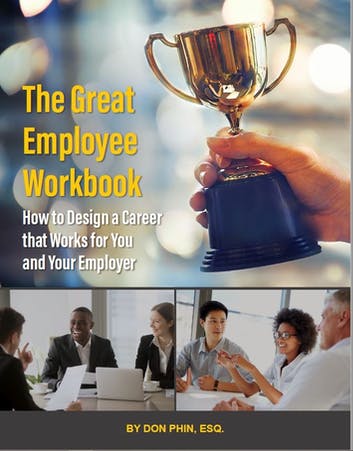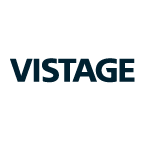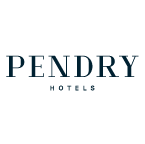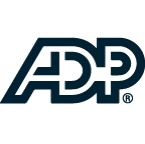What’s Inside?
The Employee Workbook and Management Workbook
I have created a fillable 50-page program workbook that can easily be saved by the employee. I also created a “how-to” manual for employers to help better implement this program.
WATCH THE ENTIRE INTRODUCTORY LESSON (13 MIN.)
COURSE DESCRIPTION
Welcome, my name is Don Phin, and I created this engaging and excellent program. I know of no training specifically designed to instruct employees how to be great at their jobs. Nobody receives this training in school, and I’m not aware of any training companies offering it (until now).
The below outline is an education in itself about what is possible in an employee’s career. It is well worth your time, so please read on…
Business owners win when their employees are focused on growing their careers. Highly engaged, motivated, and focused employees have the greatest job satisfaction, higher pay, and produce better bottom-line results.
To address what I view as an enormous void, I surveyed many leaders and managers to ask how they would define a great employee. Given those responses and my experience, I put together an online training program that will show your employees how to be great at their jobs, including how to plan for their career. I could have focused on three things or fifteen things. I settled on what I view are the ten most important ones.
Your employees should understand it is they who are responsible for their career. Management’s responsibility is to put employees in a position where they are capable of success. This program helps do just that.
Here’s The Great Employee Program outlined in detail. Each of the ten videos averages about ten to fifteen minutes. It includes insights from those leaders and managers I surveyed about the subject and then I suggest one or more exercises to do.
Introduction: Why You Want to be a Great Employee
In the introduction, I address what’s in it for the employee. I will help them to understand that their career is within their control. How great they want to be is a choice they must take full responsibility for. I will discuss the importance of their having a vision for their career, not just a fleeting thought about it. I will help them to design their career story and the Big Why’s behind it. I want people to be pumped up about going through this program!
COURSE OUTLINE
01. Be Trustworthy
When I help hire employees, I am looking for somebody that can be trusted. Trust is the most important fabric in any relationship and is based on two essential factors. Skills and desire. Skills are something you can test for. For example, half of the JAVA programmers are more skilled than the other half. Without testing you’ll never know who they are. How does the employee identify the critical skill sets, and train to improve those skills? That’s an ongoing conversation throughout one’s career.
The second part of the trust conversation centers on desire, motivation, engagement, etc. If somebody lacks desire then what good are their skills? I remind employees it is their choice of how they show up every day.
I then ask the employee to define how they are doing in critical trust factors identified in the survey
- Accountability (you understand your job)
- Responsibility (the buck stops here)
- Honesty (willing to do the “right thing”)
- Integrity (doing what you say you’ll do)
- Confidentiality (keeping private what should be) participants
All videos then conclude with an exercise and call to action.
Note: Just making people more trustworthy is worth the price of admission! Having Great Employees is priceless!
02. Be Productive
In my Vistage workshops, I often have CEOs who have invited their HR executive to be a guest. I have them go through a simple exercise. They get a blank sheet of paper and write down what each believes are the three most important strategic objectives of that HR executive. Then I have them show their lists to everyone else. And guess what- they never match!
While I am intimately familiar with performance management by MBO’s, KPI’s, and OKR’s, none of these approaches will serve us if we’re not on the same page with the three most important strategic objectives. Not matter what your job is. Getting that defined is where we’ll start. Then they have to discover what benchmarks are related to those activities. Whether you call that results, objectives, key indicators or some other name, what quality and quantity benchmarks define great performance?
I also address the importance of managing their time, having performance agreements, and focusing on results.
You want your employees to be responsible for their performance. To know their jobs, and to know when they are succeeding or failing, without having to be asked or without having to be told, because they understand their job so well.
03. Have a Plan with Goals
As Mary Kay famously said, “Most people plan their vacations better than their careers.” And this is true! When people don’t have a plan for their career they are working in what I call the grey zone. That’s not who I want working for me! Helping my employees map their careers was one of the smartest things I did as an employer.
In this lesson, I discuss the importance of defining short-term performance goals (90 days) and long-term career goals (3 to 5 years out). I stress the importance of having defined deadlines and provide tools they can use for long-term career planning and short- term 90 days “rolling” plans. I let them know if they follow this advise they can thank me in five years from now :)
04. Keep Learning
It is a sad fact that only a handful of employees make a concerted effort to educate themselves once they’ve graduated from school. Many simply do the same job, at the same level, year after year. Given tight budgets and time constraints, many employers have backed off their training initiatives which further reduces continuing education.
I remind employees of one of the great truths of success- to earn more, you must learn more. And, in the end, doing so is the employee’s responsibility.
I also share with them many low-cost ways they can educate themselves- from company-sponsored training, to TED talks, and HBR Podcasts.
05. Know Your Company
In my consulting days I did a lot of employee surveys. I was always amazed at how little employees knew about the place they worked at every day. For example, great employees will know the ownership structure, executives, administrative staff, clients, customers, products, and services. They will understand the vision, mission, values, and goals for the company. They will understand operations beyond their team environment. Most important, know how the company makes a profit and how they directly contribute to that.
I will encourage employees to do research and ask questions. To know their company! PS You can always help them with that too!
06. Look for the Opportunities
Very few employees are encouraged to think about the work they do… and therefore very few do. I don’t know about you, but I would do whoopy dances when my employees thought for themselves. “You thought for yourself! That is awesome!” Don’t you want your employees to think about how they’re going to do their jobs better? How they can give better customer service, produce more innovative products, create additional opportunities, cut out waste, etc.?
I will help your employees understand they are capable of unique contributions. Every one of them. I will help them to be a better observer of their own condition and how to think through new ideas and present them to management. I tell them don’t wait for the company to ask you for suggestions, volunteer them. I’ll give them a Creativity Checklist and an Employee Suggestion Form that will assist them in doing so.
I can tell you right now that you’ll get at least one good idea, from just one employee, that will pay for everyone going through this program. Just you watch.
07. Be a Team Player
Business is a team sport. We have to think in terms of cooperation, collaboration, and contribution. I begin by sharing some of the dynamics of being new to a team, as well as the leader on one. I will discuss the importance of having team rules and how to go about doing that.
I then share a powerful exercise they can use to instantly understand how to best support each other.
Work is fun when you are on a great team!
08. Speak Up, the Right Way
I remember reading a survey in the Wall Street Journal that said roughly half of employees would not speak up in light of illegal, immoral, or unethical conduct! This is a fear-driven response. Fear of the judgment and consequences that will follow speaking up, including the loss of job security or retaliation. Therefore, much of the workforce sits in what I call a “Culture of Silence.” This is not good. For anyone.
The Culture of Silence has devastating consequences to employee engagement, company culture, risk management, and profitability. Given my legal and emotional intelligence training background, I share techniques to help employees speak up, the right way.
09. Don’t Cause Drama
As we wrote in the book Victims, Villains and Heroes, every day we walk on to an emotional stage. When anything unfair occurs, the age-old plot of Goodness Triumphs over Evil begins. Of course, for every victim there must be a villain.
Bottom line is neither the employee, their co-workers, nor the company benefit from these destructive dramas.
In my talks with CEO’s, they tell me the number one thing that drives them crazy are these nonsense dramas. Once again, I will provide employees with techniques for staying off stage and avoid this most dangerous career trap.
10. Define Your Brand
This is a funny one to conclude with. It wasn’t on my original list, but after the survey responses I couldn’t ignore it. So I keep it short and sweet. I let your employees know people will project a story on them, and they’ll have one about themselves too, simply based on the way they dress. The point is to dress like you want success. I’m not expecting anyone to be a fashionista—but I wouldn’t suggest anyone dress like a slob or somebody stuck in the 80’s either.
Another aspect of concern was proper grooming. According to a Career Builder survey I mention, too many employees still don’t get this.
Hearing it from me, and from the other executives I surveyed, just might help.
What’s The Time Investment?
Your employees can binge-watch the sessions (roughly 100 minutes) and then visit the workbook at their own pace. The full program can be used as a half-day or full-day workshop. Or the program can be broken out into one or multiple sessions daily or weekly. The flexibility allows easy management of time.
How Do I Get Started?
If you haven’t already done so, I encourage you to watch the Introductory Lesson (link). Or, if you are ready to get this training going, click below to sign up for the program. It’s easy to do. Discount pricing is available for large groups. Setting up employee access is easy after license purchase. You will also receive a video to help guide you.
As time goes on, by investing in your employees, you’ll see a major return in your human capital.
What are you waiting for?
Click the link below to GET STARTED.
ENROLL NOW!
The Great Employee Program
I offer you 100% satisfaction. If these programs are not for you, let me know. I will quickly offer a refund. No questions asked. The only risk you have is not signing up for these programs!
Please contact me for discounts on bulk or bundled licenses. Significant discounts begin with 3 or more licenses
don@donphin.com or (619) 852-4580 (PST)



























